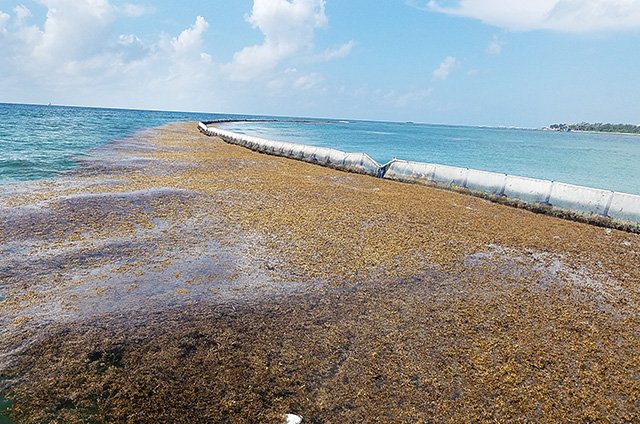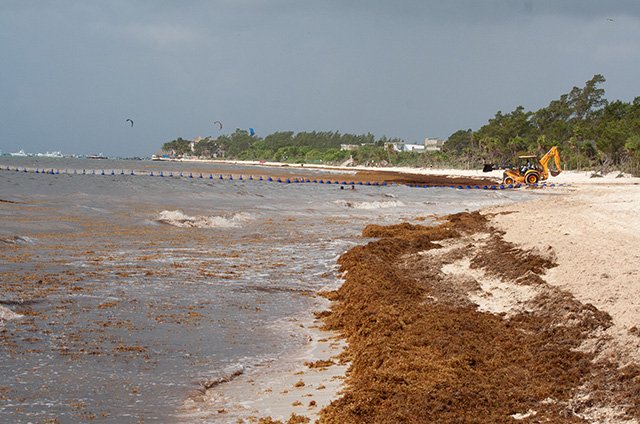Management Methods for Sargassum Inundation Events (SIEs)
Related information in Spanish
Since 2011, many governments and businesses in the coastal communities around the Gulf of Mexico and Caribbean have been interested in understanding how to predict and address the large amount of Sargassum washing up near and on their shores. Researchers are working on tools for forecasting Sargassum inundation events (SIEs) to help with preparedness and management. Once Sargassum inundates beaches and coastal areas, communities face challenging decisions on the logistics of removing, disposing, or using the massive Sargassum biomass to create sustainable or profitable products.
Forecasting Sargassum Inundation Events (SIEs)
SIEs associated with the Great Atlantic Sargassum Belt (GASB) are of international, regional, and local concern. Most jurisdictions are interested in forecasting specific landing, beaching, or inundation locations for the purposes of preparedness and management. While satellite-based monitoring provides accurate information on the general abundance and distribution of Sargassum aggregations from the GASB, specific inundation locations and impacts to coastal waters and beaches are more difficult to predict, adding to the challenge of managing the increasing frequency and size of these events. Forecasting SIEs to specific locations is extremely difficult because it depends on the unpredictability of winds and tides, as well as ocean circulation. However, the likelihood for a potential landing can be predicted regionally using historical and current satellite observations.
NOAA’s CoastWatch for the Atlantic region and University of South Florida’s Optical Oceanographic Lab have developed statistically-based Sargassum Inundation Risk reports that predict the likelihood of SIEs in the Tropical Atlantic and the Gulf of Mexico.
Texas A&M University at Galveston developed a forecasting system to help predict SIEs in the U.S. Gulf Coast, Mexico, Grand Cayman, Jamaica, Haiti, Saba, the Dominican Republic, and Puerto Rico. This Sargassum Early Advisory System can forecast inundation events up to eight days in advance.
Collection and Removal of Sargassum
Most jurisdictions affected by SIEs face the decision of whether to remove and dispose of it prior to landing or afterwards. Harvesting of Sargassum in federal waters (between 3 miles to 200 nautical miles offshore) in the South Atlantic is strictly prohibited under federal fisheries regulations. In the Southeast U.S., Gulf of Mexico, and U.S. Caribbean, Sargassum is designated as Essential Fish Habitat for several open sea fish species under the Magnuson-Stevens Fishery Conservation and Management Act. Sargassum designation as EFH means it is considered a “substrate necessary to fish for spawning, breeding, feeding, or growth to maturity.” Sargassum is also designated as Critical Habitat for loggerhead sea turtles under the Endangered Species Act in two distinct areas in the U.S. South Atlantic and Gulf of Mexico. These protected habitat designations of Sargassum legally complicate and limit its mitigation and management until it is fully beached. Additionally, the vast size of the incoming Sargassum mats and their constant movement with ocean currents present obstacles to managing Sargassum.
Collection and Removal of Sargassum from Near-coastal Waters

Some international jurisdictions in the tropical Atlantic collect and remove Sargassum from nearshore waters, prior to landing in coastal areas and beaches, but still dispose of it onshore as it is generally not practical to store on floating platforms or dispose of in the ocean. Some best practices used in removing and collecting Sargassum from nearshore waters include:
- Collect directly from the water to prevent sinking of dead or dying Sargassum
- Collect in a manner that minimizes taking sand during the process; remove any sand from the collected Sargassum
- Set clear guidelines for the process to avoid disturbing or harming marine life
- Check for trapped marine life (e.g., baby turtles)
- Ensure that storage areas and the capacity of the vessels used for the task at hand are appropriately sized
- Alert users of the areas being serviced by the removal activities
An alternative to removing Sargassum from the water column is restricting Sargassum mats from reaching the beach/coastline by deflecting them offshore using containment booms and other barriers, which have been used with mixed results. Note that in the South Atlantic region of the eastern U.S., commercial harvest of Sargassum in federal waters beyond 3 miles is prohibited, with additional rules on allowable seasons and gear for harvest. Individual U.S. states and territories may have their own permitting requirements and restrictions for Sargassum collection within nearshore state waters.
Collection and Removal of Sargassum from Beaches

Many jurisdictions, including those within the United States, collect and remove Sargassum soon after it washes onto beaches and before it decomposes. Some best practices used in collecting and removing Sargassum from beaches are:
- Remove the beached Sargassum as quickly as possible to avoid accumulation and decomposition on the beach
- Set priorities for essential areas to be cleaned, coordinate the activities among adjacent property owners and disposal sites, and develop a plan to minimize erosion and wildlife disturbance
- Avoid the use of chemicals
- Design removal and collection efforts to minimize the removal of native vegetation
- Plan and implement measures to ensure cleanup of beached Sargassum, either manually or mechanically to minimize worker exposure risks
- Equipment used in mechanical removal should be capable of adjustments that minimize sand displacement and removal
Disposal of Sargassum
The disposal of massive amounts of Sargassum that accumulates on beaches presents several challenges. Once Sargassum washes ashore, hoteliers and local governments usually remove it and pile it away out of sight from tourists or dispose of it in landfills. Both practices require the collection of excess Sargassum biomass from the beach, which is usually carried away with heavy machinery, leading to an increased risk of sand erosion. In addition, Sargassum decomposition is known to produce hydrogen sulfide and ammonia and its leachates contain bioaccumulated metals (particularly high concentrations of arsenic), pesticides, and other pollutants. As a result, certain measures should be considered during disposal to minimize potential human and environmental health effects:
- Air quality should be monitored in disposal and adjacent areas to assess exposure to hydrogen sulfide and ammonia
- Disposal areas, particularly unlined landfills located on karst substrates, should be tested for metals, pesticides, or pollutants of concern as their leachates may contaminate ground water
- Salinization of soils by salt on Sargassum can degrade soils and vegetation, so consider washing Sargassum prior to disposal if that is a concern in the disposal area
Disposal of Sargassum also has economic consequences. Landfill capacity is often limited on many tropical islands and in near-coastal communities and thus may be expensive. In addition, the cost to transport collected materials to landfills or other central location can be expensive.
Potential Uses of Sargassum
As the geographic extent and duration of blooms from the GASB increase, many jurisdictions have begun to explore novel uses for excess Sargassum biomass with the hope of turning it into economic opportunities. Some potential, but largely unstudied, proposed uses identified for Sargassum include:
- Compost and fertilizer
- Biosorbent
- Bioplastics
- Biochar/charcoal briquettes
- Adobe bricks
- Cement additive (for strength and elasticity)
- Chipboard
- Livestock and fish food
- Biofuels
- Nanostructure materials
- Soap
- Pharmaceuticals and food supplements
The use and commercial applications of Sargassum should take into consideration many factors including its capacity to bioaccumulate or leach metals (particularly, high concentrations of arsenic), metalloids, pesticides, and other pollutants such as microplastics. Additional factors to consider may include the need to remove sand, salt, and water prior to processing, as well as the potential need for long-term storage to deal with excess biomass and ensure a steady supply in the offseason.
Organizations with Sargassum Management Information
- University of South Florida- Satellite-based Sargassum Watch System (SaWS)
- United Nations Environment Programme- Sargassum White Paper: Turning the crisis into an opportunity
- Sargassum Information HUB- Protocols and Guides to Manage Sargassum
- Sargasso Sea Commission
- Center for Resource Management and Environmental Studies at The University of the West Indies Barbados
References:
- Caribbean Alliance for Sustainable Tourism (CAST). (2015). Sargassum: A Resource Guide for the Caribbean. CAST, Caribbean Hotel and Tourism Association, Coral Gables, FL.
- Carrillo-Domínguez, S., Rodríguez-Martínez, R. E., Díaz-Martínez, M., Magaña-Gallegos, E., Cuchillo-Hilario, M. (2022). Potential application of pelagic Sargassum spp. in animal feeding. J Appl Phyc, 35, 433-444.
- Dutch Caribbean Nature Alliance (DCNA). (2019). Prevention and clean-up of Sargassum in the Dutch Caribbean. DCNA, Bonaire, Dutch Caribbean.
- Devault, D. A., Pierre, R., Marfaing, H., Dolique, F., & Lopez, P. J. (2020). Sargassum contamination and consequences for downstream uses: a review. Journal of Applied Phycology, 33, 567-602.
- Endangered and Threatened Species: Critical Habitat for the Northwest Atlantic Ocean Loggerhead Sea Turtle District Population Segment (DPS) and Determination Regarding Critical Habitat for the North Pacific Ocean Loggerhead DPS, 79 Fed. Reg. 39855 (June 10, 2014) (to be codified at 50 CFR 226).
- Hinds, C., Oxenford, H., Cumberbatch, J., Fardin, F., Doyle, E., & Cashman, A. (2016). Sargassum management brief: Golden Tides: Management best practices for influxes of Sargassum in the Caribbean with a focus on clean-up. Centre for Resource Management and Environmental Studies (CERMES), The University of the West Indies, Cave Hill Campus, Barbados.
- López-Contreras, A., Núñez Valenzuela, P. N., García, B. C., Driegen, J., Huerta Lwanga, E., Domin, P., Polett Gurrola, M., Rosas-Luis, R., Verde Gómez, Y., & De Vrije, T. (2022). Sargassum in Mexico: From environmental problem to valuable resource. Wageningen Food & Biobased Research. Wageningen, Netherlands.
- Magnuson-Stevens Fishery Conservation and Management Act et seq., 16 U.S.C. §§1801-1891d (1976).
- Major. A., Margiotta, E., Green, D., Lorenzoni, L., & McClain, S. (2020). Vulnerability assessment of Sargassum impacts on the Caribbean [Final Report - Draft]. National Aeronautics and Space Administration Internship Program, Summer 2020.
- Milledge, J. J., Maneein, S., Arribas López, E., & Bartlett, D. (2020). Sargassum inundations in Turks and Caicos: Methane potential and proximate, ultimate, lipid, amino acid, metal and metalloid analyses. Energies, 13, 1523.
- Modestin, E., Devault, D. A., Baylet, A., Massat, F., & Dolique, F. (2022). Arsenic in Caribbean bivalves in the context of Sargassum beachings: A new risk for seafood consumers. Environ Monit Assess, 194, 553.
- National Oceanographic and Atmospheric Administration, Fisheries Southeast Regional Office (NOAA, SERO). (2023). Frequently asked questions regarding annual inundations of Sargassum in the Southeastern United States [Q & A]. National Oceanographic and Atmospheric Administration.
- South Atlantic Fishery Management Council (SAFMC). (2002). Fishery Management Plan for Pelagic Sargassum Habitat of the South Atlantic Region. South Atlantic Fishery Management Council. Charleston, South Carolina.
- Stevenson, M. (2022, May 3). Mexico’s Caribbean beaches awash in foul-smelling Sargassum algae. Chicago Sun Times.
- Tapia-Fuentes, J., Cruz-Salas, A. A., Martínez-Salvador, C., Ojeda-Benítez, S., Vázquez-Morillas, A., & Álvarez-Zeferino, J.C. (2023). Presence of microplastics deposited in Sargassum sp. on sandy beaches. Regional Studies in Marine Science, 66, 103152.
- Vázquez-Delfín, E., Freile-Pelegrín, Y., Salazar-Garibay, A., Serviere-Zaragoza, E., Méndez-Rodríguez, L. C., & Robledo, D. (2021). Species composition and chemical characterization of Sargassum influx at six different locations along the Mexican Caribbean coast. Sci Total Environ., 795, 148852.
- Wang, M., & Hu, C. (2016). Mapping and quantifying Sargassum distribution and coverage in the Central West Atlantic using MODIS observations. Remote Sensing of Environment, 183, 350-367.
- Wang, M., Hu, C., Cannizzaro, J., English, D., Han, X., Naar, D., Lapointe, B., Brewton, R., & Hernandez, F. (2018). Remote sensing of Sargassum biomass, nutrients, and pigments. Geophysical Research Letters, 45, 12,359-12,367.
